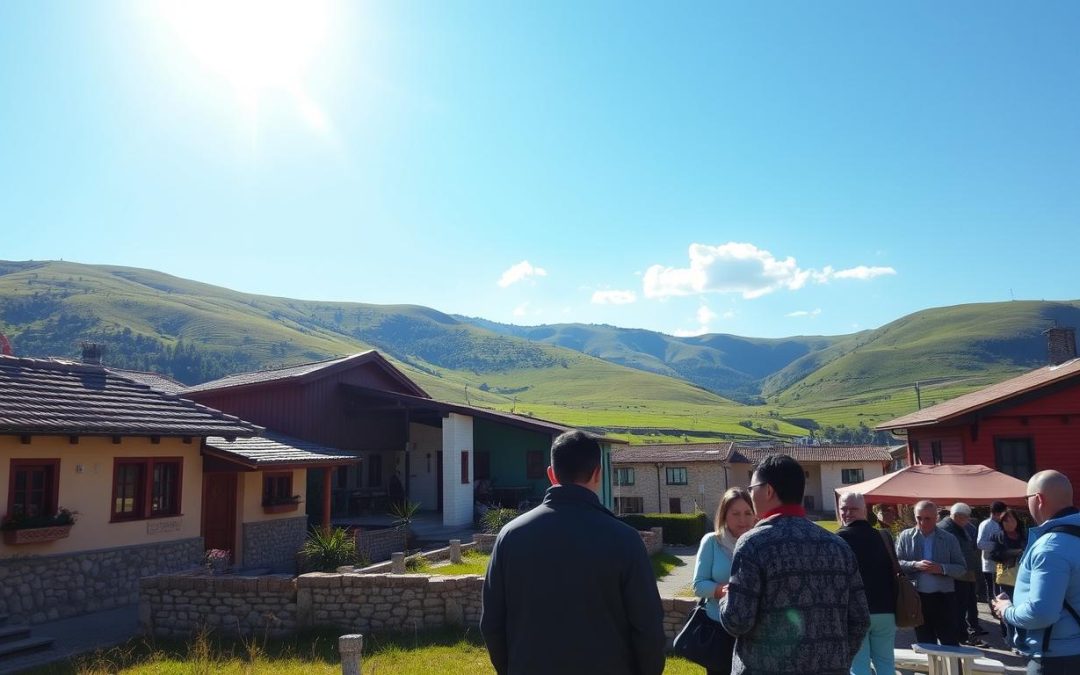Ever wondered how a small European country keeps its language so unified? In Albania, the Albanian language is more than just a way to talk. It’s the core of what makes them who they are.
In Albania, 98.76% of people speak Albanian as their first language. This makes Albania stand out in Europe. The official Albanian language is a symbol of their culture and pride.
Albania is home to 59.9% monolingual people. This shows how deeply language is tied to their identity. Let’s dive into how language shapes Albania’s culture and strength.
Key Takeaways
- Albanian is the official language spoken by 98.76% of the population
- Albania ranks fourth in Europe for monolingual inhabitants
- The Albanian language reflects strong national identity
- Two primary dialects exist: Tosk and Gheg
- Linguistic unity is a significant cultural characteristic
Overview of Albania’s Linguistic Landscape
Albania has a unique language that shows its cultural identity. The Albanian language is a treasure, telling the country’s history and pride.
The Albanian language is special. It’s the only surviving member of its language branch. It comes from the extinct Illyrian tongue. This shows Albania’s amazing cultural preservation.
National Language and Identity
Albanian is more than a way to talk. It’s the nation’s heart, showing its traditions and history. It connects families, keeping memories and ties alive.
Dialect Landscape
- Two main dialects are Geg (northern) and Tosk (southern)
- Standardized on Tosk in 1972
- Uses Roman alphabet since 1908
Language Demographics
| Region | Primary Dialect | Speakers |
|---|---|---|
| Northern Albania | Geg | Predominant |
| Southern Albania | Tosk | Predominant |
Worldwide, about seven million ethnic Albanians speak this unique language. They live in Kosovo, North Macedonia, and Montenegro too.
“Language is the road map of a culture. It tells you where its people come from and where they are going.” – Rita Mae Brown
The Albanian language is a symbol of national pride. It shows the country’s linguistic diversity and cultural strength through the years.
Albanian Language: Official Status and Usage
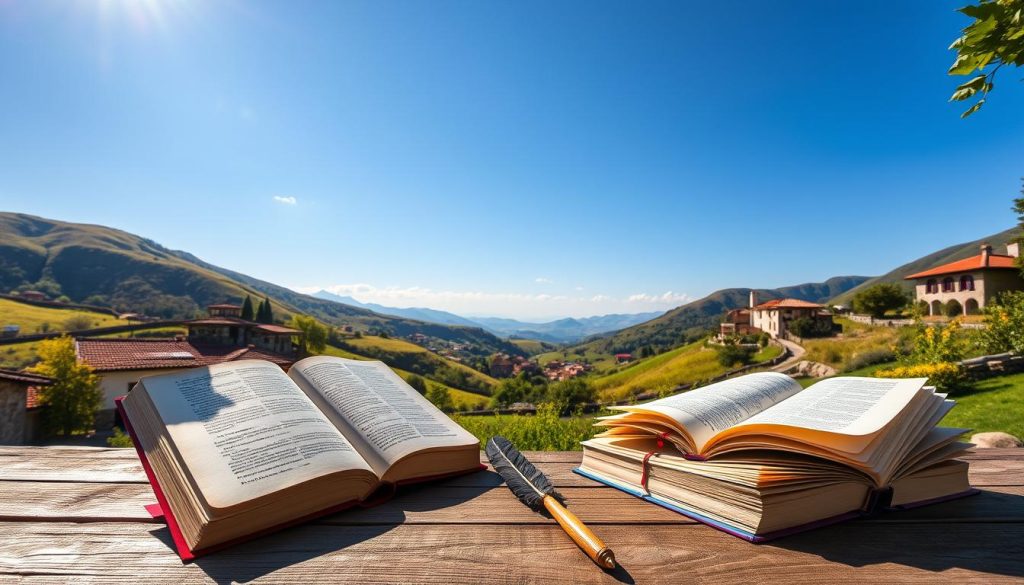
The Albanian language is a key part of national identity. It is deeply rooted in the country’s laws. Article 14 of the Albanian Constitution makes Albanian the official language of the Republic of Albania. This shows its important role in national life.
Knowing the language’s importance is more than just law. About 98.767% of people speak Albanian as their first language. It’s not just a way to talk; it’s a symbol of cultural unity and shared heritage.
- Official language since 1912
- Spoken by approximately 6.5 million native speakers globally
- Primary official language in Albania and Kosovo
Looking into Albanian language policies shows a complex scene. The standard language, mainly based on the Tosk dialect, came up during communism. It keeps changing. Its official status affects many areas:
- Government administration
- Educational systems
- Media and public communication
- Legal documentation
“Language is the road map of a culture. It tells you where its people come from and where they are going.” – Rita Mae Brown
The language policies around Albanian are key in keeping national identity alive. They help the language grow and meet global communication needs. The language’s official status helps protect and promote it in many areas of society.
Major Albanian Dialects and Regional Variations
The Albanian language is very diverse, with different dialects. These variations show the rich culture of Albania.
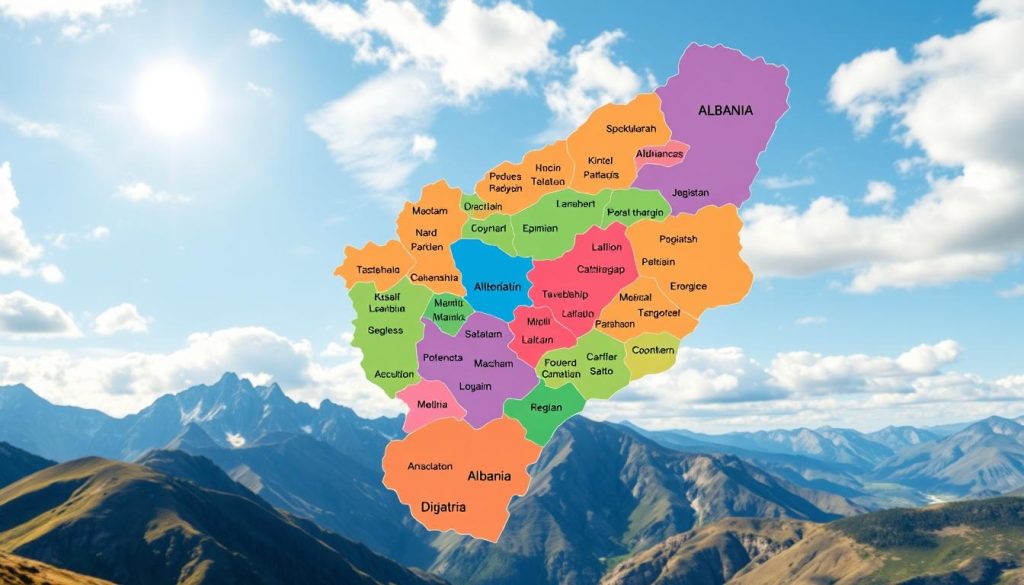
The Albanian language has two main dialect groups: Gheg and Tosk. The Shkumbin River separates them, creating a clear divide in language history.
Gheg Dialect: Northern Albania’s Linguistic Heritage
The Gheg dialect is found in northern Albania and nearby areas. It has:
- Four main sub-dialects: Northwest, Northeast, Central, and Southern Gheg
- Spoken in Montenegro, Kosovo, and parts of northwestern Albania
- Keeps old language traits from Proto-Albanian
Tosk Dialect: Southern Albania’s Linguistic Tradition
Tosk is spoken in southern Albania and is the basis for standard Albanian. It has:
- Five sub-dialects: Northern Tosk, Labërisht, Çam, Arvanitika, and Arbëresh
- Mostly spoken in areas like Berat and Fier
- Is the foundation for the written Albanian language
Dialect Mutual Intelligibility
Even though Gheg and Tosk are different, they are still understandable to each other. This shows the unity of Albanian language communities.
The diversity of Albanian dialects reflects a rich linguistic heritage that spans centuries of cultural evolution.
| Dialect Group | Primary Regions | Unique Characteristics |
|---|---|---|
| Gheg | Northern Albania, Kosovo | Nasal vowels, older linguistic features |
| Tosk | Southern Albania | Standard written language basis |
Minority Languages in Albania
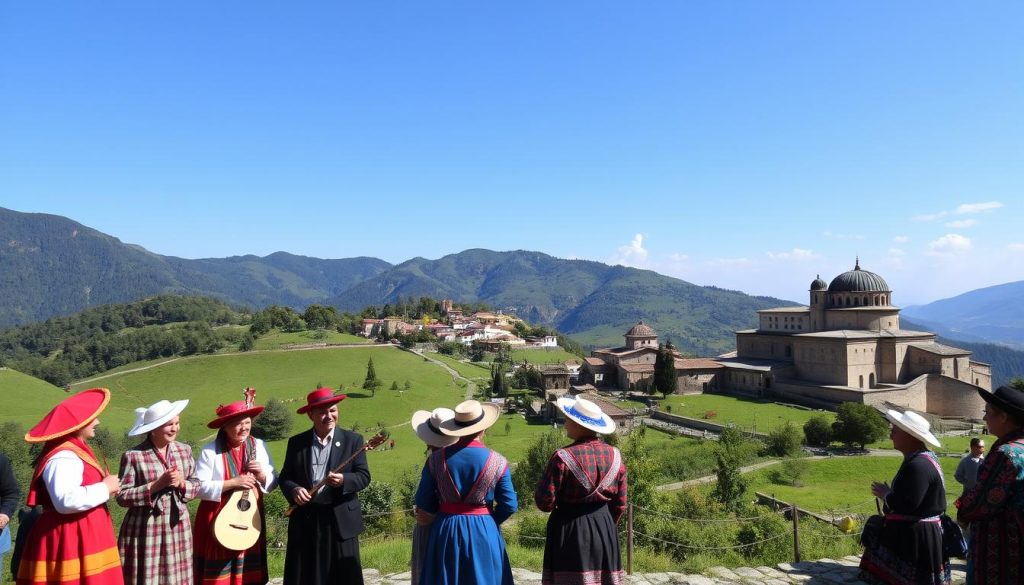
Albania is home to a rich mix of languages, beyond just Albanian. Albanian is spoken by 98.767% of people. But, the country also celebrates several minority languages, showing its diverse culture.
The main minority languages in Albania are:
- Greek (0.54% of population)
- Aromanian
- Macedonian
- Romani
- Serbo-Croatian
Greek is the most spoken minority language, found mainly in southern Albania. The Aromanian community is also significant, with 100,000 to 200,000 people keeping their culture alive.
“Language is the roadmap of a culture. It tells you where its people come from and where they are going.” – Rita Mae Brown
Romani speakers, about 10,000 strong, work hard to keep their language alive. They face challenges due to limited education. Macedonian speakers, though fewer, also enrich Albania’s language scene, with around 5,000 documented in past censuses.
Exploring Albania’s language scene shows a country dedicated to minority languages. It ensures these groups can keep their languages alive while being part of Albanian society.
Albania’s Language Policies and Minority Rights
Albania’s language policies are complex. They balance linguistic rights and cultural identity. The country aims to protect minority languages while keeping national unity.
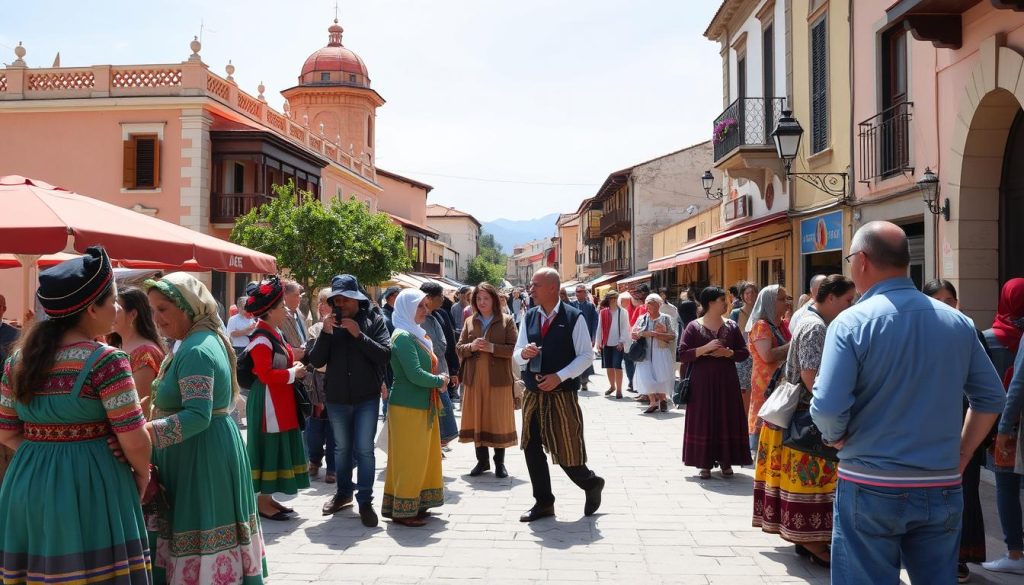
Albania’s laws recognize many ethnic groups and their language rights. The 2017 minority law offers strong protections for diverse communities.
Historical Evolution of Language Policies
In the communist era, language policies were strict. After 1991, Albania started to value cultural diversity and include more languages.
- Communist period: Uniform language restrictions
- Post-1991: Gradual expansion of linguistic rights
- 2017 law: Comprehensive minority protections
Current Language Rights and Protections
Today, nine minority groups are officially recognized. These include:
| Minority Group | Approximate Population |
|---|---|
| Greeks | 0.6% |
| Vlachs | Less than 1% |
| Roma | Approximately 0.3% |
| Macedonians | Recognized in Pustec Municipality |
Impact on Social Integration
Language policies are key to social integration. By supporting minority languages, Albania fosters cultural understanding and unity.
“Linguistic diversity is not a threat, but a strength of our national identity.” – Albanian Cultural Policy Expert
These policies help preserve culture while encouraging community interaction among different ethnic groups.
Foreign Language Proficiency in Modern Albania
Albania is moving fast in language education. It shows the country’s big push for speaking many languages. This is key for talking to the world and sharing cultures.
A study by Eurostat found that 39.9% of Albanian adults can speak a foreign language. This shows Albania is getting better at speaking different languages. It also shows the country is more open to talking to people from other places.
Popular Foreign Languages
- English: It’s getting more popular, especially among the young
- Italian: It’s important because of cultural ties
- Greek: It’s big because of where Albania is located
More people in cities can speak foreign languages than in rural areas. The tech and tourism sectors are helping make English more common. This is opening up new chances for young people to grow in their careers.
“Language is the road map of a culture. It tells you where its people come from and where they are going.” – Rita Mae Brown
Factors Driving Language Learning
- European integration goals
- Globalization
- Job chances
- Better school programs
The growing number of people speaking many languages in Albania is more than just talking. It’s about making connections, understanding others, and finding new ways to grow personally and professionally.
Italian Language Influence and Cultural Impact
The connection between Albania and Italy is deep, showing a unique cultural identity. This connection is rooted in a long history of language and cultural exchange.
Historical Roots of Italian Presence
The influence of Italian in Albania started in the 19th century. The first school teaching Italian opened in Shkodra in 1830, by Geg Kodheli. By 1861, the Franciscan school became a key place for learning Italian.
- First private Italian school established in 1830
- Franciscan school opened teaching Italian in 1861
- Saverian College introduced Italian as a main subject in 1877
Modern Media and Language Acquisition
Most Albanians learned Italian from watching Italian TV, not school. This shows the strong cultural bond between the two countries.
Contemporary Educational Landscape
Today, Italian is a key foreign language in Albania’s schools. Here are some interesting facts:
| Italian Language Education Metrics | Numbers |
|---|---|
| Schools Teaching Italian | 62 across 19 counties |
| Elementary Schools | 38 institutions |
| High Schools | 24 institutions |
| Albanian Students Learning Italian | 45% of total foreign language learners |
“Language is the road map of a culture. It tells you where its people come from and where they are going.” – Rita Mae Brown
With about 420,000 Albanians in Italy, the Italian language is vital. It shapes Albania’s language and culture.
English as a Growing Second Language
Albania’s education scene has changed a lot in the last few decades. English has become a key second language, showing Albania’s goal to be a multilingual society. Since the 1990s, English has grown fast, especially among the young.
The 2023 EF English Proficiency Index shows Albania’s strong position. It ranks 39th worldwide and 28th in Europe. This success comes from smart education plans and more international ties.
“English is no longer just a language – it’s a gateway to global opportunities for Albanian youth.”
Several factors have led to English’s popularity:
- English is taught in primary schools from third grade
- It’s needed for Master’s degrees
- More private universities offer English courses
- There’s a big need for English in jobs like call centers
Cities like Tirana and Saranda have the most English speakers. Young Albanians know that about 80% of the world’s online information is in English. This motivates them to learn English.
There’s also a growing need for English in specific areas. This includes science, law, and professional fields. This specialized English helps Albanians succeed in international work settings.
About 65% of Albanian kids speak English. The language is becoming a big part of education and work. Albania is becoming a strong player in the world’s language scene.
Conclusion
Your journey through Albania’s language shows a rich story of cultural identity. There are about 6 million Albanian speakers in the Balkans. And with a global diaspora, the language reaches 7.5 million people. This makes Albanian a strong symbol of unity and diversity.
The people of Albania are very good at speaking many languages. They have a standard dialect in Albania and Kosovo. But in other countries, Albanian is seen as a minority language. This shows how Albanian can be both specific to a region and adaptable worldwide.
Albania’s language mix shows a nation that values its past and connects with the world. The country’s language shows its social flexibility. It holds onto traditional roots while also embracing new global influences. This makes Albania a great example of how language can connect cultures and the world.
Learning about Albania’s language is more than just studying words. It gives us a peek into the nation’s heart. The way Albanians talk, keep their language alive, and connect with others shows their adaptability and deep culture.
The above is subject to change.
Check back often to TRAVEL.COM for the latest travel tips and deals.
Here are some Tours & Sightseeing suggestions that might pique your interests!
